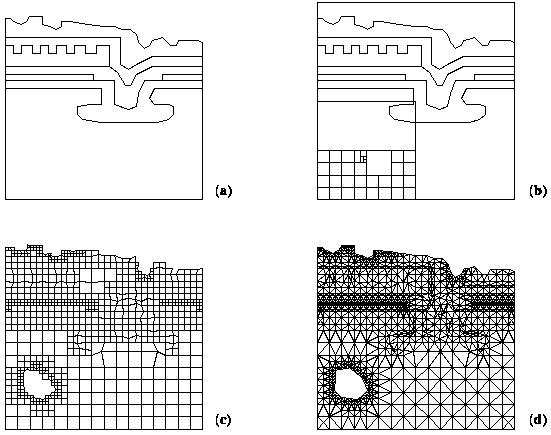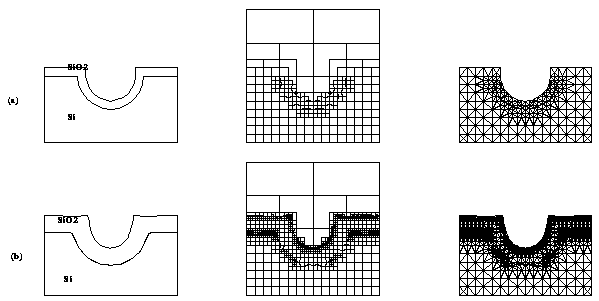Overview of FOREST
Physically based simulators like
SUPREM IV-GS, and
PISCES-2ET are used
for modeling devices and process steps in a virtual factory. Such
programs numerically solve partial differential equations on discrete
points (called a computational grid) that is representative of the
continuous physical device structure. One of the key factors
determining the efficiency and accuracy of the computed solution is
the allocation of the discrete grid. The thrust of our research is to
automatically generate an optimum grid for both device and process
simulation.
Forest, a 2D geometry and grid program, provides these capabilities.
It stores and manipulates both geometry and grid data and can be used
for diffusion, oxidation and device simulation. Quadtree based grid
generation proceeds by enclosing the structure geometry in a root
square and recursively dividing the root square resulting in a
terminated lines mesh. The level of decimation can be controlled by a
number of factors including user specification, solution variation,
etc. The terminal squares are then triangulated using templates. The
triangles are optimized for aspect ratio. For oxidation simulation,
the geometry of the device is first evolved; the quadtree is rehashed
and retriangulated. These operations are illustrated in the figures.
Used in a stand alone configuration,Forest produces PISCES-2ET mesh
or SUPREM IV structure files as output. It requires cross sectional
geometry and doping information as input; the input file can be a
SUPREM IV structure, a PIF geometry, or a forest geometry file. For
PISCES-2ET, heterojunction devices can also be specified with varying
ternary and quaternary material compositions.
Additionally, Forest, is being used as an integration tool for the
various process simulators. Forest's independent manipulation of grid
and geometry allow it to be used with grid based programs like SUPREM
IV-GS and with geometry based etching and deposition programs like
SPEEDIE 3.0.
References:
[1] Z. Sahul, R. Dutton, M. Noell. "Grid and Geometry Techniques for
Multi-Layer Process Simulation." Proc. of SISDEP'93. Springer-Verlag.
pp. 417-420.
[2] Z. Sahul, E. McKenna, R. Dutton. "Grid Techniques for Multi-Layer
Device and Process Simulation." Proc. of TECHCON'93. SRC. pp.
164-166.

Grid generation proceeds by enclosing the geometry (a) in a root square
(b) and recursively dividing the root square resulting in a terminated
lines mesh (c). The terminated lines mesh is then triangulated (d).

Use of Forest for oxidation simulation. Geometry, quadtree mesh and
triangulation before oxidation (a) and after several oxidation steps
(b).

